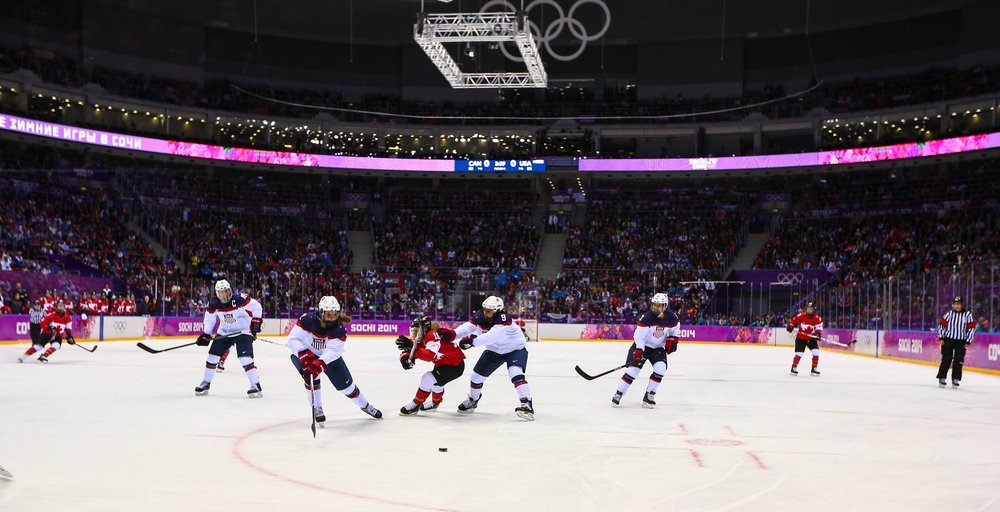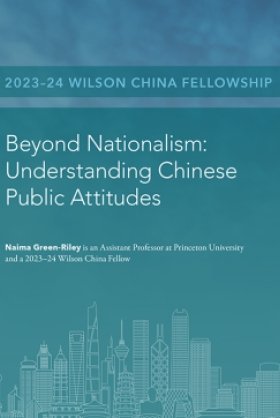Skating Across Borders: How Hockey Shapes Canadian-American Relations
As the 2024-2025 NHL season gets underway, Canada Institute Staff Assistant Intern Ronnie Di Iorio explores the history of hockey as a diplomatic tool and vessel for cultural exchange.

Shutterstock.com/Iurii Osadchi
Canadian Roots
Though evidence points to Scotland’s “Great Winter of 1608”, as the first recorded transition of traditional ‘stick-and-ball’ games to an icy arena, the contemporary sport of ice hockey acknowledges distinctly Canadian origins. Notably, in Montréal, where the International Ice Hockey Federation (IIHF) determined the first organized game to have taken place in 1875.
Like the young nation’s northern terrain, the ice hockey rink rapidly developed into a second home for Canadians and an integral aspect of their national identity. Eager to prove their strength on the global level, Canadians soon exported the sport to their southern neighbor.
By the mid-1880s Canadian and American amateur ice hockey teams were engaging in cross-border competitions. Notoriously more violent, the Canadian style of play “displayed men who were perceived to be stoic, courageous, and physically dominant” and reflected traditional perceptions of strength by the First Nations and early colonial settlers. In the sport’s early years, Canadian teams overwhelmingly dominated their American counterparts.
Not long after it had begun, the sport of Ice hockey was recognized as the de facto Canadian national sport, and in 1917 the National Hockey League (NHL), today’s premier forum for hockey, was organized. Despite initially consisting of a meager four teams, all based in Canada, the league would cross borders by the mid-1920s, with the 1925 addition of American team, the Boston Bruins. Only 50 years into its dominionship at the time of the NHL’s founding, Canada had found a niche in hockey and, with it, a way to leave a lasting mark on the international stage.
Even though the sport gained traction in the United States, it was clear that the significance of ice hockey in Canada far outweighed its American counterpart. The sport had become a tool to combat the encroachment of American cultural influence and economic dominance. Still a burgeoning nation, Canada struggled to maintain a distinct national identity against the more robust United States.
Bilateralism Outside of the Arena
While ice hockey may not be a traditional form of diplomacy, it has and continues to result in significant contributions to cultural exchanges, economic integration, and the development of bilateral relationships between Canada and the United States.
The nations’ borderlands were the first and primary recipient of the benefits of cross-border play. In the sport’s formative years, participants and spectators found that transnational tournaments boosted competitive spirits and increased social engagement across the border. Hockey accordingly developed into an unofficial medium for bilateral cultural cooperation and economic transfer.
Until 1908, Canadian hockey was played entirely at the amateur level. At this point, Canada was forced to professionalize the sport in order to compete with rapidly growing American counterparts; historians noting that their “hockey was revolutionized by American money”. Thus, as transnational ice hockey leagues grew, the Canadian and US economies were further integrated through tourism, immigration, and cross-border currency exchange. The spread of the widely popular NHL to the United States enshrined the sport as a bilateral economic endeavor.
Hockey has also played an undeniable role in US-Canadian politics, well exemplified in the latter half of the 20th century; a time of strained diplomatic relations between the nations. Former Prime Minister (PM) Pierre Trudeau had inherited a Canada disenchanted with the growing influence of the United States militarily, socially, and economically. Then-popular Canadian sentiment was aptly characterized as, “to be Canadian is to be ‘not American’" and “hockey is Canadian”.
In an attempt to distance Canada from the United States, Trudeau established an Ice Hockey Task Force in 1968, founding Hockey Canada to represent the sport on the domestic and global stages. Shortly thereafter, the Prime Minister engaged Soviet Premier Alexei Kosygin. The two agreed to host an international hockey tournament in order to boost relations between the nations: the 1972 Summit Series.
Diplomatic tensions between the United States and Canada boiled over with the NHL’s mandated exclusion of Canadian World Hockey League (WHL) players from the Series. The ensuing public outcry was the result of significant anger over the commercialization of the sport which Canadians attributed directly to the United States. Though the US government had no hand in the players’ exclusion, Canadians wrote thousands of letters to their representatives denouncing US involvement and significant monetary investment in the Canadian national sport. The PM himself publicly lamented the exclusion of Canadian WHL players from the Series and called upon the NHL to prioritize Canadian interests over American commercialization. The NHL’s refusal tarnished US public diplomacy in Canada, enforcing pre-existing stereotypes of American consumerism.
While the United States largely left hockey dealings to private actors, the Canadian government played a significant role in the diplomacy of the sport. Hockey had become a symbol of Canadian discontent with the United States. Fortunately, by the mid-1970s, the newly-elected President Ford bettered diplomatic relations between the countries, notably inviting Canada to the G7. Known for his love of sports, the President’s background as a Michigan native and youth hockey player, along with his installation of an ice hockey rink on the White House lawn increased goodwill between Canada and the United States.
Hockey relations mirrored the improved bilateral relationship, exemplified by Prime Minister Trudeau's personal appeal to President Ford on the inclusion of the United States in Canada’s inaugural ice hockey tournament: the Canada Cup. Though the US team failed to clinch a victory against the more skilled Canadians, goodwill was largely restored between the nations – at least outside of the rink.
Today, hockey diplomacy is in full swing between Canada and the United States. This year, US Ambassador to Canada David Cohen hosted the Inaugural Ambassadors Challenge Cup between members of the Canadian Embassy in Washington, DC and the US Embassy in Ottawa. Played in January 2024, the Cup brought diplomats, military personnel, and hockey enthusiasts from Canada and the United States together in a display of team spirit and good-natured rivalry. Ambassador Cohen explained “we call this Hockey Diplomacy, because diplomacy is all about bringing countries together, solving differences, figuring out how to collaborate.” Set to become an annual tradition, the Ambassadors Challenge Cup promotes the sport as an exciting avenue for cross-border collaboration between the allied nations.
Economic Impact and Industry Integration
Today, one of hockey’s most tangible effects is economic. In Canada, statistics from Scotiabank demonstrate the generation of an estimated C$11.2 billion in annual economic activity from hockey related affairs. Of this, C$2.6 billion results directly from the sport’s travel among Canadian communities and over C$1 billion affects districts with populations under 100,000 people.
Hockey admittedly plays a lesser role in the United States, following behind the widely popular NFL, MLB, and NBA, though the sport is undoubtedly growing. NHL headquarters are now in New York, 25 out of 32 NHL teams are located in the US, and the past season saw a record number of US born players in the NHL at 29.3%, second only to Canadians.
The greatest economic impact of hockey, however, has been on the integrated North American economy where the sport has steadily increased in market value. From 2000 to 2023, the binational NHL’s average franchise value rose from US $148 million to US $1.32 billion with an increase of 29% from 2022-2023 alone. In the 2023-2024 season, there were record levels of attendance, and the 32 arenas hit capacity levels of 97%.
Contemporary Hockey
Today, if you ask an American to characterize their northern neighbor, the answer usually begins with maple syrup and ends with ice hockey. Though the sport faces its challenges, it is synonymous with Canada. What many fail to acknowledge, however, is the history of the sport in the United States. Though it may be “Canada’s Game,” ice hockey in North America is undoubtedly a bilateral endeavor.
Most recently perhaps, hockey fans may note the conspicuous naming of the most recent connection between the US and Canada: The Gordie Howe International Bridge. In the bridge’s official announcement, former PM Stephen Harper explained the name, stating that Howe was “a proud Canadian who led the Detroit Red Wings to four Stanley Cup victories, building extraordinary goodwill between our countries” and it would be his “sincere hope that this bridge, which bears his name, will continue this proud legacy”. Howe’s impressive contributions to the sport, and to both nations, will be cemented with the scheduled opening of the international bridge in September, 2025.
As the sport continues to evolve, its legacy remains secure as a symbol of both collaboration and competition between Canada and the US. With political, economic, and societal ramifications, ice hockey’s impact on the Canada-US bilateral relationship underscores its enduring significance beyond the rink.
About the Author


Canada Institute
The mission of the Wilson Center's Canada Institute is to raise the level of knowledge of Canada in the United States, particularly within the Washington, DC policy community. Research projects, initiatives, podcasts, and publications cover contemporary Canada, US-Canadian relations, North American political economy, and Canada's global role as it intersects with US national interests. Read more













